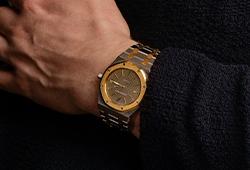Anders Zorn
"The Flea" (Dressing for Summer)
Signed Zorn and dated 1918. Oil on canvas 122 x 92 cm.
Saleroom notice
Förtydligande/tillägg till den kortfattade informationen i den tryckta katalogen: Införselmoms tillkommer på klubbat pris. För ytterligare information vänligen kontakta kundservice, alternativt +46 8-614 08 00.
Import VAT
Import VAT (12%) will be charged on the hammer price on this lot. For further details please contact customer service +46 8-614 08 00.
Provenance
Mrs. R. Levin; acquired by the family of a European collector circa 1950; private collection; Sotheby's, London, "The Scandinavian Sale (Property of a Private Collector)", 28 June 1999, lot 20; J.E. Safra Collection (acquired at the above Sale).
Exhibitions
Liljevalchs Konsthall, Stockholm, "Anders Zorn. Minnesutställning", 1 March - 6 April 1924, no. 189.
Literature
Tor Hedberg, "Anders Zorn. 1894-1920", SAK, 1924, mentioned pp. 144-145 and illustrated p. 140, Bild [Image] 96; Gerda Boëthius, "ZORN. Tecknaren, Målaren, Etsaren, Skulptören", 1949, catalogued under year 1918, p. 555, mentioned p. 513 and illustrated full page, Fig. 309; Gerda Boëthius, "Anders Zorn. An international Swedish artist. His life and work", 1954, illustrated full page, Pl. 343 (under the title "The Flea").
More information
“Dressing for summer” from 1918 is an exquisite interior from Gopsmor in which Zorn devotes himself to an in-depth study of complex lighting problems, in which different sources of light meet amid the dim chiaroscuro lighting typical of old masters. The daylight which dominates the composition enters from the window on the right-hand side, lighting the left side of the model, while the fire in the fireplace illuminates the foreground, reflected in the brick of the walls and the iron of the pot crane. The viewer can almost feel the warm air from the barely visible fire in the fireplace. Zorn also excels as a colourist where, despite his limited palette, he conjures up deep, rich yet delicate tonal painting, partly accentuated by the apron of the Mora folk costume and the hairband.
Artist
Anders Zorn, born in Mora in 1860, showed artistic talent from a young age. In 1875, he traveled to Stockholm and became a student at the then Slöjdskolan (now Tekniska högskolan) in Stockholm, and shortly after, he joined the Royal Academy of Fine Arts. Initially, Zorn had aspirations of becoming a sculptor, but soon watercolor painting took over, becoming his primary medium until 1887. At the student exhibition in 1880, Zorn had his breakthrough with the watercolor painting "I sorg." The following year, he gained international acclaim as a portrait painter. His watercolor painting reached its pinnacle during this period, and his most famous work from this time is "Vårt dagliga bröd” from 1886. Shortly thereafter, Zorn transitioned to oil painting, which was met with immediate success. Zorn's reputation mainly rested on his portrait art, and he portrayed many notable figures, including presidents. For instance, he created an etching of Theodore Roosevelt. His etchings significantly contributed to his success. In the late 1880s, Zorn began working in the genre that would increasingly become his trademark: nude figures in outdoor settings. He had long been fascinated by the movement of water and the reflections of light on its surface. Now, he added the complexity of placing a model near or in the water, aiming to depict a synthesis between nature and humanity. In 1896, Zorn and his wife moved back to Sweden and settled in Zorngården in Mora. This move sparked a renewed interest in his homeland, which would be reflected in his future paintings. Among the artist's scenes from the Mora region, portraying its local customs and ancient traditions, "Midsommardansen" holds the highest value according to Zorn himself. Today, the painting can be found at the National Museum.
Read more



































